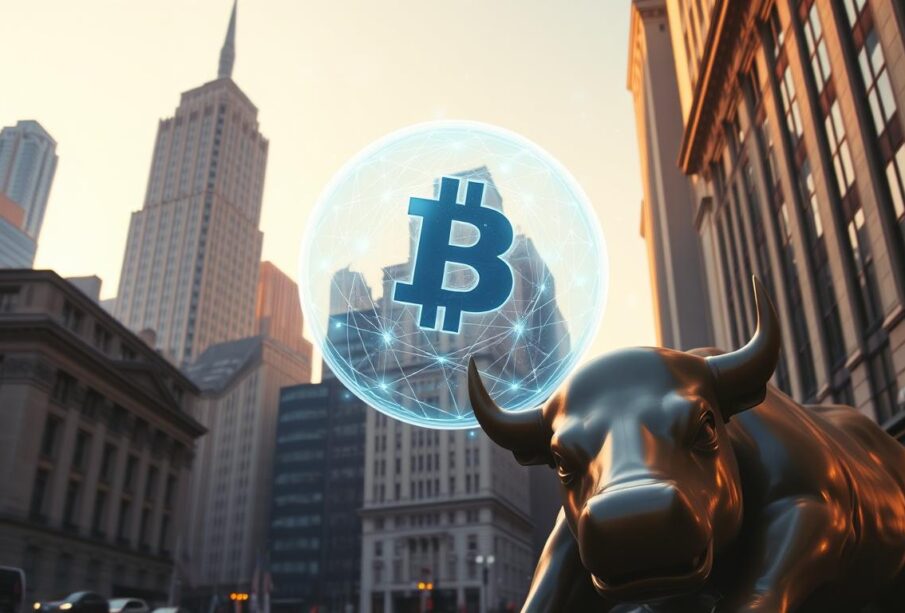Trump’s crypto embrace opens the door to a Wall Street overhaul

Donald Trump’s recent embrace of cryptocurrency has sent shockwaves through the financial world, potentially paving the way for a significant overhaul of Wall Street. With the former president’s endorsement, the digital currency landscape is poised for a major shift.
This development is expected to have far-reaching implications, influencing the way financial transactions are conducted and regulated. As the crypto landscape evolves, it is likely to attract more investors and users, driving growth and innovation in the sector.
Key Takeaways
- The adoption of cryptocurrency is gaining momentum.
- Trump’s support could lead to a more favorable regulatory environment.
- A Wall Street overhaul may involve the integration of digital currencies.
- The financial sector is on the cusp of a significant transformation.
- Investors and users are likely to benefit from the growth of the crypto market.
The Evolution of Trump’s Stance on Cryptocurrency
From skepticism to advocacy, Trump’s cryptocurrency stance has seen a remarkable evolution. Initially, Trump expressed concerns about digital currencies, but over time, his views have shifted towards embracing their potential.
From Skepticism to Advocacy
Trump’s journey from being a skeptic to an advocate of cryptocurrency is noteworthy. His change in stance has been influenced by the growing adoption of digital assets and their potential impact on the financial system. As the digital landscape continues to evolve, Trump’s advocacy is likely to shape the future of cryptocurrency regulation.
The shift in Trump’s stance is not just a change in personal opinion but also reflects a broader understanding of the technology behind cryptocurrencies, such as blockchain. This technology has the potential to revolutionize various sectors beyond finance, including supply chain management and healthcare.
Key Statements and Policy Shifts
During his campaign and after the election, Trump made several key statements regarding digital assets. These statements have been crucial in understanding his policy shifts towards cryptocurrency.
Campaign Promises Related to Digital Assets
Trump’s campaign promises related to digital assets included plans to foster innovation while protecting consumers. He emphasized the need for clear regulations that would support the growth of the cryptocurrency market without stifling its potential.
- Encouraging innovation in the blockchain space
- Protecting consumers from fraudulent activities
- Establishing clear regulatory guidelines
Post-Election Cryptocurrency Initiatives
After the election, Trump’s initiatives towards cryptocurrency continued to evolve. His administration has been working on policies that support the development of digital assets while ensuring financial stability.
Some of the post-election initiatives include:
- Exploring the potential of central bank digital currencies (CBDCs)
- Enhancing regulatory frameworks for cryptocurrency exchanges
- Promoting the use of blockchain technology in government services
These initiatives demonstrate Trump’s commitment to embracing the potential of cryptocurrency and blockchain technology, marking a significant shift in his stance.
The Current State of Crypto in American Finance
The cryptocurrency landscape in American finance is undergoing significant changes. As digital assets become more mainstream, the financial sector is adapting to new regulatory, technological, and investor-driven realities.
Regulatory Challenges and Opportunities
The regulatory environment for cryptocurrency in the U.S. is complex and evolving. On one hand, clear regulations could provide much-needed stability and confidence for investors. On the other hand, overly restrictive regulations might stifle innovation. The current challenge lies in striking a balance between protecting investors and fostering growth in the digital asset space.
Recent developments, such as the SEC’s stance on cryptocurrency ETFs, highlight the ongoing efforts to navigate this delicate balance. The regulatory landscape is expected to continue evolving, presenting both challenges and opportunities for market participants.
Institutional Adoption Trends
Institutional adoption of cryptocurrency is on the rise, driven by increasing demand for digital assets as an investment class. Major financial institutions are now offering cryptocurrency-related products and services, marking a significant shift in the industry.
- Institutional investors are diversifying their portfolios with cryptocurrency.
- Investment banks are developing cryptocurrency custody solutions.
- Asset managers are launching cryptocurrency funds.
This trend is expected to continue, with more institutions entering the cryptocurrency market and driving further growth and maturity.
Retail Investor Participation
Retail investors are also playing a crucial role in the cryptocurrency market. The ease of access to digital assets through various platforms has democratized investment opportunities, allowing individual investors to participate in the market.
Retail investor participation is driven by factors such as:
- The potential for high returns on investment.
- Increasing awareness and education about cryptocurrency.
- The accessibility of cryptocurrency trading platforms.
As the market continues to evolve, understanding the dynamics of retail investor participation will be essential for stakeholders across the financial industry.
Potential Regulatory Overhaul Under a Crypto-Friendly Administration
With a new administration embracing cryptocurrency, the stage is set for a comprehensive overhaul of existing regulations. This shift could have far-reaching implications for the financial sector, potentially fostering innovation and increasing the adoption of digital assets.
The current regulatory environment has been a subject of debate, with many arguing that it is either too restrictive or too lenient. A crypto-friendly administration could bring about a more balanced approach, addressing the concerns of both proponents and critics of cryptocurrency.
SEC Oversight Reforms
One of the key areas likely to see significant changes is the oversight role of the Securities and Exchange Commission (SEC). Reforms could include clearer guidelines on the classification of digital assets, potentially reducing the regulatory ambiguity that currently surrounds many cryptocurrency projects.
Clearer classification guidelines could help projects understand their regulatory obligations, potentially reducing the risk of non-compliance. This, in turn, could increase investor confidence, as the regulatory environment becomes more predictable.
Banking Regulations and Digital Assets
Another area that could see significant changes is banking regulations as they pertain to digital assets. A more crypto-friendly administration might introduce regulations that allow for greater integration of digital assets into traditional banking systems, potentially increasing their accessibility and usability.
The integration of digital assets into banking could also lead to the development of new financial products and services, further expanding the role of cryptocurrency in the financial sector. This could include decentralized finance (DeFi) solutions, which have been gaining popularity.
Tax Policy Changes for Cryptocurrency Investors
Tax policies related to cryptocurrency investments are also likely to undergo significant changes. A crypto-friendly administration might introduce more favorable tax treatment for cryptocurrency investors, potentially encouraging greater participation in the market.
Changes could include clarifications on the tax treatment of various cryptocurrency transactions, such as those involving non-fungible tokens (NFTs). Clearer guidelines could reduce the complexity and uncertainty that currently surrounds the tax obligations of cryptocurrency investors.
By providing a more favorable regulatory environment, a crypto-friendly administration could help to promote the growth and development of the cryptocurrency market in the United States.
Wall Street’s Transformation: Traditional Finance Meets Blockchain
The intersection of traditional finance and blockchain is redefining the landscape of Wall Street. As this convergence continues to evolve, it’s reshaping the way financial institutions operate, innovate, and interact with investors.
Investment Banks Adapting to Cryptocurrency
Investment banks are increasingly adapting to the rise of cryptocurrency by integrating blockchain technology into their operations. This involves developing new financial products, enhancing security measures, and improving transaction efficiency.
Key adaptations include:
- Developing cryptocurrency trading desks to cater to growing client demand
- Investing in blockchain-based infrastructure to enhance security and efficiency
- Creating new financial products linked to cryptocurrency performance
Asset Management Firms Embracing Digital Assets
Asset management firms are also embracing digital assets, recognizing their potential to diversify portfolios and enhance returns. This shift involves updating investment strategies to include cryptocurrencies and other blockchain-based assets.
| Firm | Digital Asset Strategy | Blockchain Adoption |
|---|---|---|
| BlackRock | Investing in cryptocurrency funds | Utilizing blockchain for asset tokenization |
| Vanguard | Exploring cryptocurrency index funds | Implementing blockchain for secure transactions |
| Fidelity | Offering cryptocurrency custody services | Developing blockchain-based trading platforms |
New Financial Products and Services
The convergence of traditional finance and blockchain is giving rise to new financial products and services. These innovations are designed to meet the evolving needs of investors and financial institutions alike.
Some notable examples include:
- Blockchain-based ETFs
- Cryptocurrency index funds
- Tokenized assets representing real-world assets
Bitcoin’s Role in Reshaping American Financial Markets
As the cryptocurrency landscape evolves, Bitcoin is increasingly becoming a pivotal force in reshaping American financial markets. Its influence extends across various domains, from corporate treasury assets to institutional investment strategies.
Bitcoin as a Corporate Treasury Asset
Several major corporations have started to adopt Bitcoin as a treasury asset, diversifying their financial holdings and signaling confidence in its long-term value. This trend is exemplified by companies like MicroStrategy, which has significantly invested in Bitcoin, viewing it as a store of value akin to gold. The adoption of Bitcoin as a corporate treasury asset not only hedges against inflation but also positions companies to capitalize on the potential upside of cryptocurrency.
“Bitcoin is a significant store of value, and its adoption as a treasury asset is a strategic move towards diversifying corporate finances,” notes a financial analyst. The implications of this trend are far-reaching, potentially leading to a more robust financial position for companies and a broader acceptance of cryptocurrency in mainstream finance.
Institutional Investment Strategies
Institutional investors are increasingly incorporating Bitcoin into their investment portfolios, driven by its potential for high returns and diversification benefits. The growing involvement of institutional investors is a testament to Bitcoin’s maturing ecosystem and its recognition as a legitimate asset class. Investment strategies range from direct Bitcoin investment to more sophisticated financial products, such as futures and options.
The table below highlights some key institutional investment strategies involving Bitcoin:
| Investment Strategy | Description | Risk Level |
|---|---|---|
| Direct Investment | Investing directly in Bitcoin | High |
| Bitcoin Futures | Investing in Bitcoin futures contracts | High |
| Bitcoin ETFs | Investing in Exchange-Traded Funds (ETFs) that track Bitcoin | Medium-High |
Bitcoin ETFs and Mainstream Accessibility
Bitcoin ETFs have emerged as a crucial instrument for enhancing mainstream accessibility to Bitcoin. By providing a regulated and straightforward way to invest in Bitcoin, ETFs have made it easier for both retail and institutional investors to participate in the cryptocurrency market. The approval of Bitcoin ETFs by regulatory bodies marks a significant milestone in the integration of cryptocurrency into traditional financial markets.
The introduction of Bitcoin ETFs has been met with enthusiasm, as it offers a familiar investment vehicle for those looking to gain exposure to Bitcoin without directly holding the cryptocurrency. This development is expected to further drive the adoption of Bitcoin, contributing to its role in reshaping American financial markets.
“The introduction of Bitcoin ETFs is a game-changer for the cryptocurrency market, making it more accessible and appealing to a broader range of investors,” said a leading financial expert.
Ethereum and Altcoins: Building the New Financial Infrastructure
Ethereum and altcoins are at the forefront of building a new financial infrastructure, leveraging smart contracts and tokenization. As the financial landscape continues to evolve, these technologies are poised to play a crucial role in shaping the future of financial transactions and services.
Smart Contracts Revolutionizing Transactions
Smart contracts, primarily facilitated by Ethereum, are automating various financial processes, reducing the need for intermediaries and increasing efficiency. “Smart contracts are self-executing contracts with the terms of the agreement written directly into lines of code.” This innovation is transforming the way transactions are conducted, making them more secure, transparent, and cost-effective.
For instance, in the insurance sector, smart contracts can automate claims processing, ensuring that payouts are made quickly and accurately. Similarly, in supply chain management, smart contracts can facilitate real-time tracking and payment settlements, enhancing the overall efficiency of the supply chain.

Promising Altcoins in the New Regulatory Environment
While Ethereum has been a pioneer in the smart contract space, various altcoins are emerging with unique features and use cases. Polkadot, for example, is enabling interoperability between different blockchain networks, further expanding the potential of decentralized applications. Other altcoins like Solana and Cardano are also gaining traction due to their scalability and innovative consensus mechanisms.
The new regulatory environment, shaped by clearer guidelines on cryptocurrency, is likely to boost the adoption of these altcoins. As regulatory clarity increases, institutional investors are becoming more comfortable investing in these assets, driving further innovation and growth in the sector.
Tokenization of Traditional Assets
Tokenization, the process of converting traditional assets into digital tokens on a blockchain, is another significant trend. “Tokenization represents a paradigm shift in the way we think about ownership and transfer of assets.” It allows for fractional ownership, increased liquidity, and more efficient transfer of assets.
Real estate, art, and even commodities are being tokenized, opening up new investment opportunities for a broader range of investors. This trend is expected to continue growing as the infrastructure for tokenization becomes more robust and user-friendly.
In conclusion, Ethereum and altcoins are not just alternative investments; they are building blocks of a new financial infrastructure. Through smart contracts, innovative altcoins, and tokenization, they are revolutionizing financial transactions and services, paving the way for a more efficient, accessible, and inclusive financial system.
Decentralized Finance (DeFi): Challenging Wall Street’s Dominance
As DeFi continues to grow, it’s becoming increasingly clear that this decentralized approach to finance could challenge traditional Wall Street institutions. Decentralized Finance, or DeFi, represents a paradigm shift in the financial sector, leveraging blockchain technology to create a more open and accessible financial system.
Lending and Borrowing Without Traditional Banks
One of the most significant aspects of DeFi is its ability to facilitate lending and borrowing without the need for traditional banks. This is achieved through decentralized lending protocols that allow individuals to lend their assets and earn interest, or borrow assets by providing collateral. This model not only democratizes access to financial services but also potentially reduces the costs associated with traditional banking.
For instance, platforms like Compound and Aave have pioneered decentralized lending, allowing users to interact directly with smart contracts to lend or borrow cryptocurrencies. This disintermediation could significantly impact traditional banking models by reducing the need for intermediaries.
Automated Market Makers vs. Traditional Exchanges
DeFi has also introduced Automated Market Makers (AMMs), which are revolutionizing the way assets are traded. Unlike traditional exchanges that rely on order books, AMMs use liquidity pools to facilitate trading. This model not only enhances liquidity but also reduces the barriers to entry for new assets and traders.
Uniswap, a prominent AMM, has demonstrated the potential of this model by providing a decentralized alternative to traditional cryptocurrency exchanges. The liquidity pool mechanism ensures that there is always a buyer or seller available, thus enhancing market efficiency.
Yield Generation Strategies in DeFi
DeFi has also opened up new avenues for yield generation, allowing investors to earn returns on their assets in various ways. From liquidity mining to staking, DeFi protocols offer multiple strategies for generating yield. This has attracted a new wave of investors looking to maximize their returns in a low-interest-rate environment.
However, it’s crucial to note that DeFi yield generation strategies come with their own set of risks, including smart contract risk, market volatility, and regulatory risks. Investors need to be cautious and conduct thorough due diligence before participating in DeFi yield generation activities.
Economic Implications of a Wall Street Crypto Revolution
The crypto revolution on Wall Street is poised to bring about significant economic changes, affecting various aspects of the financial landscape.
Job Creation in the Digital Asset Sector
The integration of cryptocurrency and blockchain technology is expected to create new job opportunities in the digital asset sector. Some of the emerging roles include:
- Crypto asset managers
- Blockchain developers
- Digital asset analysts
- Crypto compliance officers
These roles will not only be limited to tech-savvy individuals but will also include professionals from financial, legal, and regulatory backgrounds.
Wealth Distribution Effects
The crypto revolution could lead to a more democratized financial system, potentially reducing wealth inequality. Early adopters and those with the knowledge and means to invest in cryptocurrencies have seen significant gains.
However, it’s crucial to consider the risks and ensure that the benefits are distributed fairly across different segments of the population.
Innovation and Competitiveness in Global Markets
The adoption of crypto and blockchain technology on Wall Street is likely to drive innovation, making the US financial sector more competitive globally. This could lead to:
- New financial products and services
- Enhanced security and transparency
- Increased efficiency in transactions
As a result, the US is likely to maintain its competitive edge in the global financial markets.

The economic implications of a Wall Street crypto revolution are multifaceted, with potential benefits including job creation, more equitable wealth distribution, and enhanced innovation and competitiveness.
International Positioning: America as a Crypto Superpower
The rise of cryptocurrency presents a unique opportunity for America to establish itself as a crypto superpower on the world stage. As the global financial landscape evolves, the U.S. is strategically positioning itself to leverage the benefits of digital currencies and blockchain technology.
To achieve this status, America must compete with emerging global crypto hubs. Countries like Singapore, Switzerland, and the United Kingdom are actively creating crypto-friendly regulations to attract businesses and talent. The U.S. must balance regulatory oversight with innovation-friendly policies to remain competitive.
Competing with Global Crypto Hubs
The global crypto landscape is rapidly evolving, with various countries vying for dominance. To maintain its position, the U.S. needs to foster a conducive environment for crypto businesses, including clear regulations and tax policies that encourage innovation.
Key factors in competing with global crypto hubs include:
- Developing clear and consistent regulatory frameworks
- Encouraging innovation through tax incentives and subsidies
- Investing in blockchain education and workforce development
Dollar Dominance in the Age of Digital Currencies
The U.S. dollar’s status as a global reserve currency is a significant advantage in the crypto era. As digital currencies become more prevalent, maintaining dollar dominance will be crucial for America’s financial influence.
The implications of dollar dominance in digital currencies are multifaceted:
- It reinforces the dollar’s position in global trade and finance
- It provides the U.S. with greater control over financial sanctions and geopolitical leverage
- It encourages the development of dollar-denominated digital assets
Geopolitical Advantages of Crypto Leadership
Leading in cryptocurrency and blockchain technology offers significant geopolitical advantages. It allows the U.S. to shape global financial standards, enhance its economic influence, and promote financial inclusion.
By embracing crypto leadership, America can:
| Geopolitical Advantage | Description |
|---|---|
| Shaping Global Standards | Influencing international regulations and standards for digital assets |
| Economic Influence | Enhancing the U.S.’s position in global finance and trade |
| Financial Inclusion | Promoting access to financial services through blockchain technology |
Conclusion: The Future of American Finance in a Crypto-Integrated World
As the United States moves towards a more crypto-friendly regulatory environment, the implications for Wall Street and American finance are profound. Trump’s embrace of cryptocurrency has opened the door to a potential overhaul of traditional financial systems, paving the way for a crypto-integrated world.
This shift is expected to drive innovation, increase competitiveness, and create new opportunities in the financial sector. With the rise of decentralized finance (DeFi) and the growing adoption of digital assets, American finance is on the cusp of a significant transformation.
In this emerging landscape, the United States is poised to strengthen its position as a global financial leader. By embracing cryptocurrency and blockchain technology, America can foster a more dynamic and inclusive financial system, ultimately shaping the future of american finance.
FAQ
What is the significance of Trump’s crypto embrace for Wall Street?
Trump’s crypto embrace is significant for Wall Street as it could lead to a potential overhaul of the traditional financial system, paving the way for greater adoption of digital assets and blockchain technology.
How has Trump’s stance on cryptocurrency evolved over time?
Trump’s stance on cryptocurrency has evolved from initial skepticism to advocacy, with key statements and policy shifts during his campaign and after the election, indicating a more favorable view of digital assets.
What are the current regulatory challenges facing the crypto industry in the US?
The crypto industry in the US faces regulatory challenges, including unclear SEC oversight, banking regulations that hinder digital asset adoption, and tax policies that need to be more favorable for cryptocurrency investors.
How is Wall Street adapting to the rise of cryptocurrency and blockchain technology?
Wall Street is adapting to the rise of cryptocurrency and blockchain technology through investment banks and asset management firms embracing digital assets, and the development of new financial products and services.
What role is Bitcoin playing in reshaping American financial markets?
Bitcoin is playing a significant role in reshaping American financial markets, including its adoption as a corporate treasury asset, institutional investment strategies, and the impact of Bitcoin ETFs on mainstream accessibility.
How are Ethereum and altcoins contributing to the new financial infrastructure?
Ethereum and altcoins are contributing to the new financial infrastructure through smart contracts revolutionizing transactions, promising altcoins in the new regulatory environment, and the tokenization of traditional assets.
What is the potential impact of Decentralized Finance (DeFi) on traditional financial systems?
DeFi has the potential to challenge traditional financial systems by enabling lending and borrowing without traditional banks, automated market makers vs. traditional exchanges, and yield generation strategies in DeFi.
What are the economic implications of a Wall Street crypto revolution?
The economic implications of a Wall Street crypto revolution include job creation in the digital asset sector, wealth distribution effects, and the impact on innovation and competitiveness in global markets.
How can America position itself as a crypto superpower?
America can position itself as a crypto superpower by competing with global crypto hubs, maintaining dollar dominance in the age of digital currencies, and leveraging the geopolitical advantages of crypto leadership.
What are the potential tax policy changes for cryptocurrency investors?
Potential tax policy changes for cryptocurrency investors could include more favorable tax treatment for digital assets, which could foster innovation and adoption in the crypto space.






